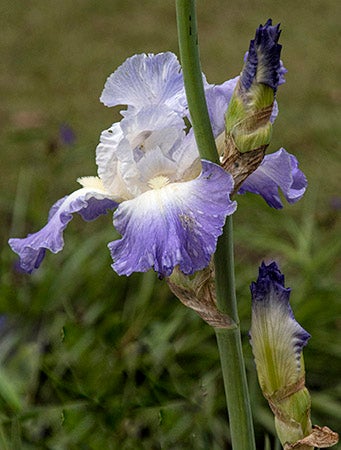Gardening at the end of the season
Published 6:00 am Thursday, December 2, 2021

- In a protected location, iris remontant just keep on blooming in late fall.
|
Getting your Trinity Audio player ready...
|
The days are short; so short that it’s dark long before I usually stop working in the garden. The air is crisp, and the nights are cold.
It’s the end of the gardening season, but I still haven’t had a killing frost in my garden. In fact, the lantanas, chrysanthemums, camellias, reblooming irises, angel wing begonias, and gentians are still blooming. Friends say that I clearly live in a special, magical, frost-free zone. Not really, there’s just a stone wall around the garden that provides a tremendous amount of protection for many of my plants.
Chilly weather, frost, and short days usually mean the end of gardening until early spring, but not anymore. The first killing frost seems to arrive later every year, so there’s plenty for a gardener to do. As long as the ground isn’t frozen, it’s no too late to stick the last of the spring blooming bulbs in the ground. Just make sure to bury them deep enough and to mark their location so that you don’t accidentally dig them up in early spring.
This is the perfect time to thin boxwood. Plucking out pieces here and there opens the interior of the plants so that they get better air circulation, thus helping to prevent the spread of diseases. What to do with the pieces of boxwood that are removed? They’re perfect for use in holiday decorations.
As long as the ground isn’t frozen, it’s not too late to plant trees. While shoots are dormant in late fall and winter, trees establish roots in new locations before warm weather stimulates top growth, thus enabling trees to better withstand the upcoming hot, dry summer weather.
And, yes, there are some cleanup chores that should be done. Dead plants should be removed from the vegetable garden and a cover crop, such as ryegrass, vetch or turnips, should be planted and then tilled under in early spring. Cover crops are important because they help improve soil structure, increase microbial activities in the soil, reduce soil compaction and improve the nitrogen content of the soil.
It’s all right to delay cutting back deciduous perennials until late winter or early spring as they provide food and shelter for insects and small mammals. If you want to prune roses at the end of the growing season, it’s important to wait until the weather is consistently cold. Pruning too soon after the first hard killing frost followed by warmer weather may encourage roses to produce new growth.
The most important task of all, however, is just to sit, relax and observe the landscape. The garden isn’t dead. There are new colors and textures and a stillness that wasn’t there earlier. Examine the details of seedheads, spent blooms, and even leaves. Many are quite beautiful.
Congratulations to our neighbor and friend, Margo Reed at Woodhenge Gardens in North Garden. Her daylily, Dances with Giraffes, just received the Lenington Award, an annual award for the daylily voted the best performer over a wide geographic area. It’s a tall plant that definitely makes a statement.
DR. CYNTHIA WOOD is a master gardener. Her email address is cynthia. crewe23930@gmail.com.




